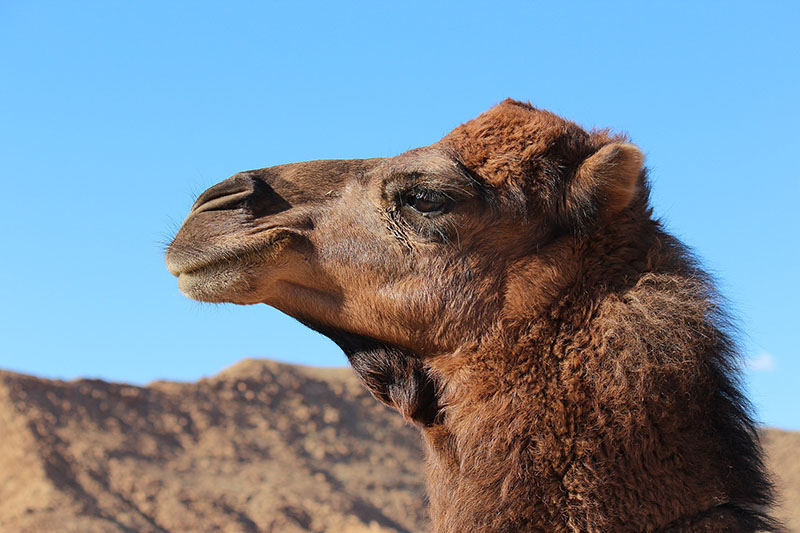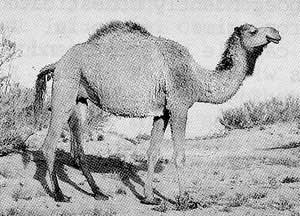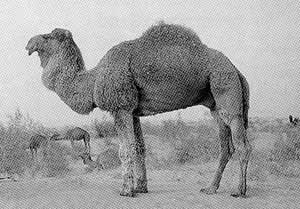Arvana Dromedary Camel
 These animals are examples of the Arvana breed of dromedary camels. This breed was
developed in Turkmenistan thousands of years ago. For the nomadic Turkoman population
living in the Kara-Kum desert, the Arvana has been the only animal supplying milk,
meat, wool and transportation for almost a millennia. Rock drawings of one-humped
camels, probably domesticated, have been found in the northwest foothills of the Sultan-Uizdag
in northern Turkmenistan and the settlement of Byash-Tyube which dates to 3000-1500
BC. Some rock drawings in the Chendir ravine on the western slopes of the Kopet-Dag
in southwest Turkmenistan depict domesticated dromedaries and riders and date to the
beginning of our current era. The possibility that dromedaries were independently
domesticated in Turkmenistan and in Arabia 5000-6000 years ago cannot be excluded.
These animals are examples of the Arvana breed of dromedary camels. This breed was
developed in Turkmenistan thousands of years ago. For the nomadic Turkoman population
living in the Kara-Kum desert, the Arvana has been the only animal supplying milk,
meat, wool and transportation for almost a millennia. Rock drawings of one-humped
camels, probably domesticated, have been found in the northwest foothills of the Sultan-Uizdag
in northern Turkmenistan and the settlement of Byash-Tyube which dates to 3000-1500
BC. Some rock drawings in the Chendir ravine on the western slopes of the Kopet-Dag
in southwest Turkmenistan depict domesticated dromedaries and riders and date to the
beginning of our current era. The possibility that dromedaries were independently
domesticated in Turkmenistan and in Arabia 5000-6000 years ago cannot be excluded.
The Arvana is typically a milk yielding, pack carrying and smooth riding breed of camel. The present day qualities have been archived by long selection: special attention was paid to the use of sires out of high milk yielding females. Arvanas have the highest milk yield of all breeds in the world.
 Arvana dromedaries are reared in all parts of Turkmenistan, as well as in Uzbekistan,
Azerbaijan and southern districts of Kazakhstan. They are also found in Turkey, northern
Iran and Afghanistan, where they may have been introduced by the Turkmen migrants
in the 12th century during the conquest of these countries by the Seljuks.
Arvana dromedaries are reared in all parts of Turkmenistan, as well as in Uzbekistan,
Azerbaijan and southern districts of Kazakhstan. They are also found in Turkey, northern
Iran and Afghanistan, where they may have been introduced by the Turkmen migrants
in the 12th century during the conquest of these countries by the Seljuks.
Arvana camels are not adapted to severe winters. In zones of high humidity they are susceptible to parasitic blood diseases and helminthasis and are defenseless against bloodsucking insects.
Arvana camels are early maturing. They reach maturity before the age of two years. The females are mated when they reach three years of age and have a live weight of 350-400 kg. Males are used for service from 4-5 to 15-16 years of age. Breeding is restricted to the season from January to April. Gestation period is, on average, 385 days and the females give birth about every two years. Shortening the calving interval as practiced in Turkmenia makes possible two calves in three years.
The live weight of the calves at birth is 38-40 kg. Their rapid live weight gain is maintained during the first year of life, the average daily live-weight gain being 950-1030 g. Weaning is done at the age of one year.
The lactation period lasts 15-18 months. Females are milked by hand 2-6 times per day depending on the yield. Machine milking is also practiced. For a group of females in the camel breeding from Sakar-Chaga average milk yield was 4387 kg in 18 months, the yield of the first calves being 3117 kg. The average daily yield of some animal amounted to 15 kg, the top yield being 19 kg. In addition to the amount needed for suckling calves, females can give 1718 kg of marketable milk with 1.13% of fat in a 12 month lactation.
 The average wool clip of males is 3.28 kg and females that of 2.10 kg. The fleece
wool of adult Arvana camels totals 91.2% of the clip (the rest is threads and tips)
and the clean wool yield of fibers is 78.6%. The local population uses camel wool
for production of natural yarn and knitted wear.
The average wool clip of males is 3.28 kg and females that of 2.10 kg. The fleece
wool of adult Arvana camels totals 91.2% of the clip (the rest is threads and tips)
and the clean wool yield of fibers is 78.6%. The local population uses camel wool
for production of natural yarn and knitted wear.
The main advantage of camels as beasts of burden consists in their ability to traverse deserts and in being cheap load carriers. In an 8-10 hour working day Arvana camels can carry packs weighing 200-300 kg for a distance of 30-35 km.
References
Dmitriez, N.G. and Ernst, L.K. (1989) Animal Genetic Resources of the USSR. Animal Production and Health Paper Publ. by FAO, Rome, 517 pp.
